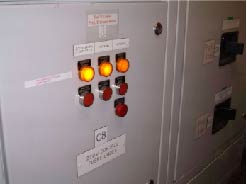Inadvertent opening of circuit breakers
A member has reported an incident in which an essential 440V circuit breaker onboard a vessel was inadvertently opened, in error, by an engineer. Whilst there was no injury, damage or loss of position keeping capability, the incident had a significant cost in terms of vessel downtime and project delays.
The vessel was working very close (within 500 metres) to a floating offshore structure and an ROV was deployed at the time. A vessel engineer was asked to check the status of a crane breaker in the switch room. However, in doing so he pressed the open/reset command buttons on the switchboard and inadvertently caused the ‘essential services’ circuit breaker to trip out. The incident resulted in the recovery of the ROV onboard and the vessel moved away from the floating offshore structure whilst an investigation into the cause of the incident was carried out.


The company conducted an investigation and identified a number of issues:
- Supervision and control of the work was not effective:
- the engineer acted contrary to the instructions given, which were to check the status of the aft crane breaker and report back
- the engineer decided on his own initiative to reset the breakers. In this context he did not fully understand his job role and responsibilities or the limits of his authority for critical operations
- The information given by various indicators and signs was unclear:
- the breaker status lights showed ‘orange’ (amber) as the normal operating condition. This was potentially confusing and should ideally be ‘green’ to reflect a more obvious normal operating condition
- labelling explaining the function of the breaker command buttons (open/reset) on the switchboard was not sufficiently explicit and was open to interpretation
- a large amount of signage had accumulated over time on the switchboard room doors, some of which was unnecessary, and the sign for ‘authorised personnel only’ was not sufficiently prominent;
- Barriers and controls were not adequate:
- the doors to the vessel switchboard rooms were not locked and entry could be gained by any onboard personnel. These are critical areas and entry should be strictly controlled;
- Existing procedures were not adequate and were not followed:
- there was no procedure or work instruction to control entry to the switchboard room or operation of the breakers by others and the chief engineer’s standing orders were not sufficiently explicit in this area
- a record of the vessel engineer having completed a formal engine room familiarisation was not available, and a number of competence portfolios, including that of the vessel engineer, had not been completed or verified
- the chief engineer’s standing orders were not signed by the full complement of vessel engineering personnel.
The company implemented a number of specific actions to prevent recurrence:
- Chief engineer’s standing orders were amended with instruction that the electrician is the nominated person responsible for operation of the equipment within the switchboard rooms and on the switchboards. In his absence, only the duty engineers who have been formally familiarised and assessed as competent may carry out switchboard operation, with regular documented familiarisation tours to ensure the duty engineer is suitably knowledgeable and familiar;
- Chief engineer’s standing orders were amended with instruction that all doors to switchboard rooms should be kept locked at all times when no work is ongoing in the room. Nominated key-holder arrangements should be put in place to ensure robust control of entry to the switchboard rooms;
- All vessel engineering personnel should sign off on having read and understood the chief engineer’s standing orders and these should be regularly reviewed and updated;
- A review of whether or not all personnel have undergone the vessel specific familiarisation required for their role, with an adequate record of this having taken place;
- A review of the competence portfolios of all vessel personnel in order to establish the status of their assessment and verification of personnel competence.
Safety Event
Published: 8 April 2010
Download: IMCA SF 02/10
IMCA Safety Flashes
Submit a Report
IMCA Safety Flashes summarise key safety matters and incidents, allowing lessons to be more easily learnt for the benefit of all. The effectiveness of the IMCA Safety Flash system depends on Members sharing information and so avoiding repeat incidents. Please consider adding safetyreports@imca-int.com to your internal distribution list for safety alerts or manually submitting information on incidents you consider may be relevant. All information is anonymised or sanitised, as appropriate.
IMCA’s store terms and conditions (https://www.imca-int.com/legal-notices/terms/) apply to all downloads from IMCA’s website, including this document.
IMCA makes every effort to ensure the accuracy and reliability of the data contained in the documents it publishes, but IMCA shall not be liable for any guidance and/or recommendation and/or statement herein contained. The information contained in this document does not fulfil or replace any individual’s or Member's legal, regulatory or other duties or obligations in respect of their operations. Individuals and Members remain solely responsible for the safe, lawful and proper conduct of their operations.
